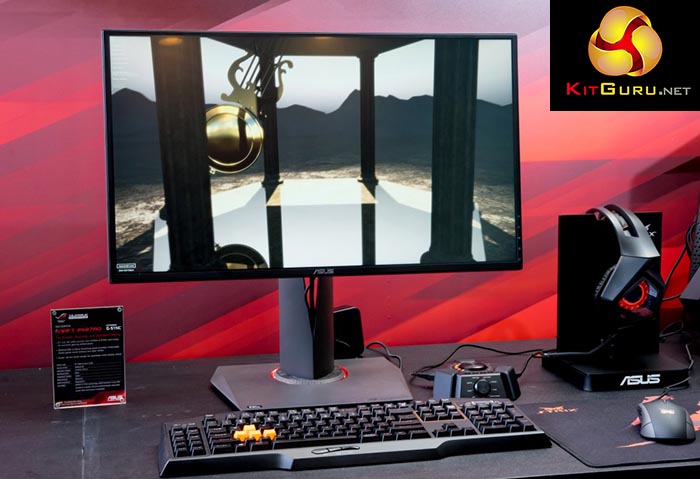There’s so much to like about the Asus ROG Swift PG27AQ. First off, it’s great that it’s an IPS panel. Despite the lower response times of TN technology, in a side-by-side comparison, IPS wins every time. The superior viewing angles, and the generally better overall picture quality are preferable, so we’d always choose an IPS display over TN, given the choice. To now have that with 4K and G-Sync is great.
G-Sync only goes up to 60Hz with the PG27AQ so the effect isn’t quite as striking as on a 144Hz display, but gaming at 4K with the smooth tear-free animation of G-Sync was still a great experience. Battlefield 4 ran as superbly as we could have hoped and having G-Sync enabled really enhanced the experience.
In general, the picture quality is superb. We recorded some great colour accuracy results, a low black point, and a gamma of 2.2 that was precise, even in an uncalibrated state. And don’t forget that Delta E result below 1.
We recorded a low figure for brightness in our testing, but to reiterate, the PG27AQ does not appear dull or washed out in any way and this is not an issue.
The Spyder 4 measures a screen’s maximum brightness value, a setting that a user may choose to reduce anyway.

The contrast levels make up for it. With 550:1 ratios it looks impressive in our testing, but subjectively, in person the PG27AQ looks really good. We played games on it for quite some time and it was hard to go back to the picture quality of an older display with worse contrast.
Even so, the PG27AQ is most definitely a gaming display rather than one for graphic design. The low brightness might be an issue for artists, but the lack of multiple gamma settings is likely to more of a problem. For those users, a ProArt display is a better choice from Asus.
Possibly the deal breaker for graphic designers is the poor brightness uniformity we recorded, with serious deviation across the panel, worse than other screens, with some backlight bleed in the bottom right as well. Both of these are unforgivable in a display aimed at graphic designers, but again, it’s not an major issue with a gaming display.
That said, it still offers great colour accuracy and a 10-bit panel though.
The build quality is as good as you could hope for. The red illuminated logo and ring around the stand are a bit of a gimmick, but the thin bezel and the stand’s ability to pivot and rotate are excellent. We generally prefer internal power supplies to the external one that comes with the PA27Q, but even that has a very stylish look.
Even the speakers are just right. At no point did they sound tinny, and bass comes through clear, although as you might expect, it isn’t particularly loud as they are still just monitor speakers.
The Asus OSD and its associated joystick control on the rear of the screen is another plus point for the physical design, and its probably the best OSD control system on the market. One quick tap brings up the various menus, and another hides them again. There’s very little lag. It’s the best we’ve seen on any display.
The OSD also looks good, it’s fast, as simple as it needs to be, which makes it very easy to navigate, and it stays out of the way. A number of other manufacturers make a good effort with their OSD, but many others fall short, while Asus is far ahead in this area. One thing we would have liked is the ability to customise the shortcuts, to add frequently used functions to the buttons, and maybe a few more options like gamma controls might have helped too.
There are a few other minor criticisms. Due to technical limitations, Asus has had to cut support for 3D Vision and ULMB (ultra-low motion blur), which will be annoying for anyone who particularly likes either feature. According to Asus, ULMB wasn’t possible with a 4K G-Sync device.
The 60Hz G-Sync limit might put some people off, if they want a super-fast refresh rate for gaming performance. A current 144Hz model from any manufacturer will certainly enhance the adaptive-sync effect, but up to that 60Hz limit, it still works very well on the PG27AQ. But as we explained, 4K at 144Hz is not possible until DisplayPort 1.3 hardware hits the channel.
For them, Asus has another new screen, the 1440p PG279Q, which runs at up to 165Hz, offering just enough bandwidth to squeeze into a DisplayPort 1.2 cable.
And there’s another fairly good reason to not worry too much about 144Hz 4K performance – few people have a rig to run the most recent games in 4K at that frame rate, at least with all the detail settings turned up to maximum anyway.
Potentially, 4K at 27 inches has a PPI that’s a bit too low to comfortable. Windows 10 addresses this issue and automatically increases the size of text and icons to fit a screen resolution, which works well, so you don’t really notice this, but 4K is always more impressive on larger screens, so we’d love to see Asus come up with a version of this screen with a screen size of 32 inches or more. The PA32AQ? You read it here first.
And while it’s great to see Asus has gone to every effort to provide more than just a single DisplayPort connector, we just want a full quota of inputs like on any other display. It’s embarrassing that such expensive screens are limited in this way, when a cheaper monitor isn’t, but Asus has recognised this and at least gone to the effort of adding a circuit for HDMI, something absent from most G-Sync displays at the moment.
The price is perhaps the last thing to mention. At £799, the PG27AQ is unfortunately out of the reach of many gamers. Asus is not really overcharging for the PG27AQ as it offers a wide and unique set of features that go a long way towards justifying the expense, but it’s still beyond many people’s budgets.
But many of the best things in life unfortunately aren’t free, and the PG27AQ offers the best experience of 4K gaming we’ve yet seen. It’s worth the extra money.

Buy from Overclockers UK for £799.99 inc vat HERE.
Discuss on our Facebook page, over HERE.
Pros:
- 4K, G-Sync and IPS are a unique combination.
- Brilliant OSD design.
- The joystick makes navigation easy.
- Superb contrast level.
- 10-bit colour support, 4ms response time, flicker-free panel.
Cons:
- High-end pricing for a high-end monitor.
- Not as bright as competing displays.
- No Nvidia 3D Vision, or ULMB.
Kitguru Says: The PG27AQ is the best 4K gaming monitor on the market.

 KitGuru KitGuru.net – Tech News | Hardware News | Hardware Reviews | IOS | Mobile | Gaming | Graphics Cards
KitGuru KitGuru.net – Tech News | Hardware News | Hardware Reviews | IOS | Mobile | Gaming | Graphics Cards



For 4K @ 144Hz, they can just add second DP 1.2, similar to 5K displays. Could be more future proof, as most cards have multiple DP outputs.
The initial 4K displays used multiple displays inputs and that didn’t work well at all. Loads of problems with tearing and such.
Wasn’t that because the displays were set up to treat the 4K screen as two separate “halves”?
Yeah, and that’s what you’d have to do with TristanSDX’s solution.
Weren’t the early panels physically 2 panels though? I seem to recall hearing that the split wasn’t just logical, that a single 4K panel was too expensive to make back then so two cheaper 1920*2160 panels were stuck together in a single frame to make it work.
Why couldn’t the bandwidth provided by the 2 DP cables be aggregated without having to virtually split the screen into two halves?
Leo should have done a video review of this.
Any way to get this in the USA yet???
You can get it now at Newegg. And some time soon Amazon will have it in stock.
You say that gsync effect is striking at 144hz and less so at 60hz? 144hz does not and never has needed adaptive sync to make it impressive. I really wonder if some of the people singing gsync praises had ever used a high refresh monitor before they tested gsync. All the explanations of the benefits gsync has at 120hz and above are actually the benefits of 120hz and above.